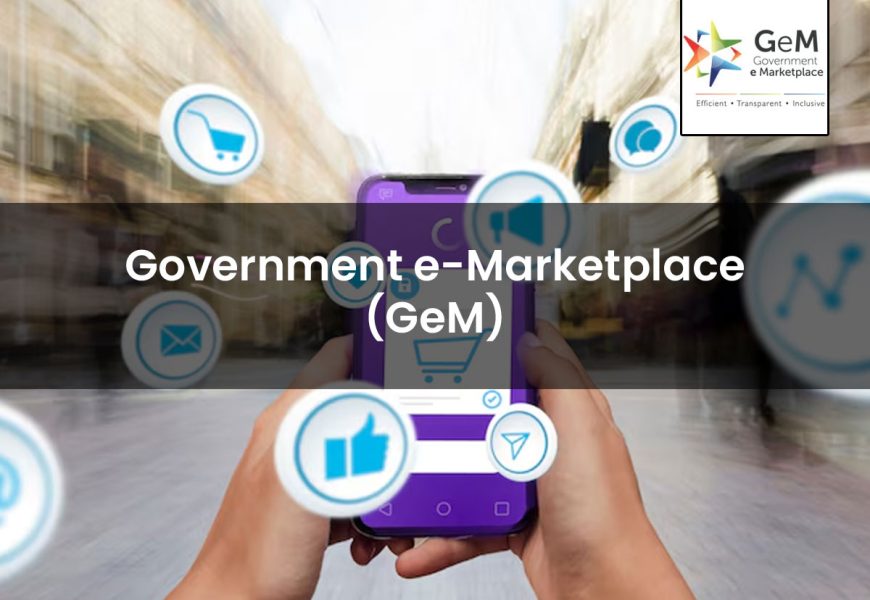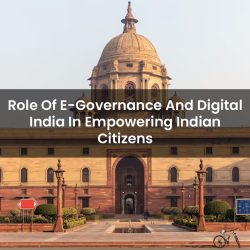The Government e-Marketplace (GeM) is a national online portal designed to meet the procurement needs of Central and State Government Departments, autonomous institutions, Public Sector Units, and local bodies. Launched on August 9, 2016, GeM aims to promote transparency, efficiency, and inclusiveness in public procurement. Through GeM, government entities can procure a wide range of goods and services, including computer supplies, projectors, and human resources, all through a streamlined, end-to-end solution.
This system has achieved a 10% savings in public procurement costs over five years, yet it currently accounts for only 5% of India’s total government purchases, which amount to approximately Rs 20 lakh crore annually. Impressively, 56% of the order value processed through the GeM portal has been delivered by Micro, Small, and Medium Enterprises (MSMEs), with seven lakh small firms actively participating on the platform.
This article will cover all the important details of this scheme, like advantages, disadvantages,
What is a Government E-Marketplace?
The Government e-Marketplace (GeM) is an online platform designed to streamline public procurement in India. Launched on August 9, 2016, by the Ministry of Commerce and Industry, this initiative aims to create a transparent and open procurement system for government buyers.
Developed in just five months, GeM facilitates the online procurement of goods and services. The Ministry of Finance has made purchases through GeM mandatory for government users by introducing Rule No. 149 in the General Financial Rules, 2017. This platform is managed by GeM SPV (Special Purpose Vehicle), a 100% government-owned, non-profit company under the Ministry of Commerce and Industry.
GeM is a contactless, paperless, and cashless marketplace that replaced the Directorate General of Supplies and Disposals (DGS&D) in 2016. Since its inception, GeM has enhanced visibility and transparency in public procurement, transforming the process in India. It focuses on three pillars: inclusion, usability, and efficiency, leading to significant cost savings. An independent World Bank assessment reports average savings of about 9.75% for buyers on the GeM portal.
As part of its commitment to transparency, the Government of India has mandated that sellers display the ‘country of origin’ for products listed on GeM. Sh. Prashant Kumar Singh, the current CEO of the Government e-marketplace, oversees this initiative. He is an IAS officer from the 1993 batch of the Manipur cadre. His leadership and expertise have been instrumental in GeM’s success.
Inception of E-marketplaces
It originated from recommendations by two Groups of Secretaries to the Prime Minister in January 2016. They suggested creating a dedicated e-market for goods and services procured or sold by the Government and PSUs, along with reforming the Directorate General of Supplies and Disposals (DGS&D). Following this, the Finance Minister, in the FY 2016-17 Budget speech, announced the establishment of a technology-driven platform to facilitate procurement across various government ministries and agencies.
With technical support from the National eGovernance Division (Ministry of Electronics and Information Technology), DGS&D developed the GeM portal for procuring both products and services. The Commerce & Industry Minister officially launched the portal on August 9, 2016. To support procurement through GeM, necessary changes were made to the General Financial Rules. Currently, the GeM portal offers over 7,400 products across about 150 categories, including transport services. Transactions exceeding Rs 140 Crore have already been processed via GeM.
GeM is a fully paperless, cashless, and system-driven e-marketplace, facilitating the procurement of common use goods and services with minimal human interaction.
Main Objectives of Government E-marketplaces (GeM)
GeM’s three key pillars—Efficiency, Transparency, and Inclusiveness—make business in the Government e-Marketplace quick and straightforward. It is inclusive, allowing anyone to conduct business on GeM, efficient, ensuring smooth business operations; and transparent, promoting fair business practices. GeM enhances openness, effectiveness, and speed in public procurement, offering various methods like direct purchase, electronic bidding, electronic reverse auction, and direct reverse auction. This digital platform leverages economies of scale, efficient price discovery, and the spread of best practices.
According to Rule 149 of the General Financial Rules 2017, ministries, government agencies, and Public Sector Enterprises must procure goods and services through the GeM portal. State Governments are also encouraged to make their purchases via GeM.
Facilities in Government E-marketplaces
- Listing of Products: Access a wide range of products in various categories of goods and services commonly used.
- Dynamic Pricing: Easily look up, estimate, compare, and buy products based on current market prices.
- Marketplace Buying: Purchase the most common user items directly from the marketplace.
- Online Procurement: Buy goods and services online as needed.
- Single Window System: Simplified demand aggregation and ordering through a single portal.
- Transparency: Enjoy transparent and straightforward buying processes.
- Low and Bulk Value Purchases: Ideal for both low-value purchases and bulk buying at competitive prices through reverse auction/e-bidding.
- Vendor Rating System: Benefit from a continuous vendor rating system for better decision-making.
- User-Friendly Dashboard: Monitor purchases, supplies, and payments easily with a user-friendly dashboard.
- Return Policy: Take advantage of a straightforward return policy for purchases.
Initiatives Taken by GeM
In June 2021, Shri Parshottam Rupala, Union Minister of State for Agriculture & Farmer’s Welfare, launched a dedicated web page on the GeM portal for bamboo products and quality planting materials, ‘The Green Gold Collection.’ Additionally, to assist proprietors in managing large-scale orders, GeM introduced the GeM SAHAY app on the Google Play store, enabling them to secure loans against their purchase orders.
On World Environment Day 2021, GeM introduced a new product category for ‘Green Room Air Conditioners’ on its portal. Furthermore, in response to the COVID-19 pandemic, GeM launched a dedicated page for COVID-19 products in June 2021, facilitating the procurement of emergency supplies such as oxygen cylinders, concentrators, and testing kits.
As a testament to its commitment to inclusivity, GeM opened its platform for onboarding specially-abled sellers under the initiative ‘Divyangjan Entrepreneurs’ in June 2021. Additionally, in October 2020, GeM integrated the Central Public Procurement Portal (CPPP) with its platform, launching the Unified Procurement System for goods and services. This included new functionalities like the “GeM Availability Report and Past Transaction Summary” and “custom bids.”
In December 2019, GeM conducted a two-month-long national outreach program called GeM Samvaad to facilitate seller onboarding and address the specific procurement needs of buyers. To support startups, GeM introduced the GeM Start-up Runway in April 2019, enabling them to sell innovative products and services to government users.
In February 2019, GeM launched the SWAYATT initiative, promoting Startups, Women, and Youth Advantage through eTransactions on the GeM portal. This initiative was inaugurated by Suresh Prabhu, the Union Minister of Commerce & Industry and Civil Aviation. Earlier that year, on January 14, the Union Government launched ‘Womaniya on Government e-Marketplace,’ an initiative empowering women entrepreneurs and Women Self-Help Groups to sell handicrafts, handloom items, and accessories directly to government departments.
The National Mission on GeM (NMG) was launched on September 5, 2018, by Commerce and Industry Minister Suresh Prabhu to accelerate the adoption and use of GeM by major central ministries, states, UTs, and their agencies, including CPSUs, PSUs, and local bodies.
Features of Government E-marketplaces
GeM aimed to create transparency and boost effectiveness, all while maintaining security and future prospects. Let’s discuss in brief detail how it was enabled to do so.
Transparency
GeM brings a high level of transparency to public procurement by reducing human intervention in vendor registration, order placement, and payment processing. As an open platform, GeM imposes no entry barriers for legitimate suppliers wishing to do business with the Government. At every stage, notifications are sent via SMS and email to buyers, their heads of organisations, paying authorities, and sellers. Payments on GeM are online, cashless, and time-bound, facilitated through integration with PFMS and the State Bank Multi Option System (SBMOPS). Integration with payment systems of Railways, Defence, major PSUs, and State Governments is also underway. These streamlined processes and mandatory online, time-bound payments have boosted vendor confidence and reduced administrative costs associated with chasing payments.
Efficiency
GeM enhances efficiency in procurement. Direct purchases can be made within minutes, with the entire process being online and integrated. The platform provides tools for assessing price reasonability. For higher-value procurements, GeM offers a transparent and efficient bidding/Reverse Auction (RA) system. Buyers can quickly create and finalise bids/RAs using standardised technical specifications within a minimum of 7 days. Notifications of new bids/RAs are sent via email and SMS to all eligible suppliers, ensuring fair competition, speed, and efficiency in price discovery. The platform allows for online comparison with market prices on leading e-commerce portals, further confirming the reasonableness of rates.
Security
GeM is a secure platform where all documents are e-Signed by buyers and sellers at various stages. Supplier antecedents are verified online through databases like MCA21, Aadhaar, and PAN. Additionally, SEBI-empaneled credit rating agencies conduct third-party assessments of suppliers, strengthening due diligence. For high-value bids/RAs, an e-Bank Guarantee is being introduced. This robust system is an improvement over traditional methods that rely on financial instruments (EMD) for guaranteeing good conduct by suppliers, and ensuring thorough checks for all procurement values.
Supporting ‘Make in India’
GeM supports the ‘Make in India’ initiative by allowing filters for selecting goods compliant with Preferential Market Access (PMA) and those manufactured by Small Scale Industries (SSI). This makes it easy for government buyers to procure ‘Make in India’ and SSI products. Accessible Management Information Systems (MIS) enable administrators and policymakers to enforce government regulations on PMA and SSI sourcing effectively. Leading computer manufacturers have started placing PMA-compliant products on GeM.
Cost Savings
The transparency, efficiency, and ease of use provided by the GeM portal have resulted in substantial cost savings for the government. Average prices on GeM are 15-20% lower than those from traditional tendering, rate contracts, and direct purchases, and sometimes even up to 56% lower. GeM also aggregates demand for common goods and services across various government departments, driving prices down further through standardised specifications and economies of scale. This demand aggregation is expected to result in annual savings of approximately Rs 40,000 crore.
Future Potential
GeM is poised to become the National Public Procurement Portal (NPPP), aligning with global best practices. Similar platforms in OECD countries like the USA, South Korea, the UK, and Singapore have resulted in annual savings of billions of dollars in public procurement while also boosting domestic industries. GeM’s continued development and adoption will bring significant benefits to public procurement in India.
Shortcomings of GeM
Every coin has two sides and every scheme has its own drawbacks. Here’s how GeM falls short:
Multiple Portals
There are various procurement portals used by different Central government departments, such as the Defence Procurement Portal and the Indian Railways e-Procurement System. These multiple platforms can limit GeM’s efforts to achieve its mandate as the National Public Procurement Portal, hindering the benefits of economies of scale and efficiency that a unified platform could provide.
Lack of Compliance
GeM also faces challenges in ensuring full compliance with Rule 149 of the General Financial Rules (GFR) 2017. This rule mandates that all common-use goods and services available on the GeM portal must be procured through it. Getting all Central organisations to adhere to this requirement remains a bit of a hurdle.
FAQs about Government E-marketplaces
What is a Government e-marketplace (GeM)?
Government e-Marketplace (GeM) is an online platform created by the government to facilitate the procurement of commonly used goods and services by various government departments, organizations, and Public Sector Units (PSUs).
Who is the CEO of GeM?
Prashant Kumar Singh has been the Chief Executive Officer (CEO) of Government e-Marketplace (GeM) since March 25, 2021. He is an Indian Administrative Service officer from the 1993 batch.
What are the three pillars of GeM?
GeM is built on three key pillars: Efficiency, Transparency, and Inclusiveness. These principles ensure that business transactions on the platform are quick, fair, and open to all.
How do I create a seller account on GeM?
The steps to start selling on GeM are easy. They are as follows:
- Go to the GeM website at [gem.gov.in](https://gem.gov.in).
- Click on "Signup" and select "Seller/Service Provider."
- Choose your business type and proceed.
- Read and accept the GeM terms and conditions.
- Enter the relevant information about your business.
- Verify your identity using AADHAAR or PAN.
- Create your User ID and Password.















